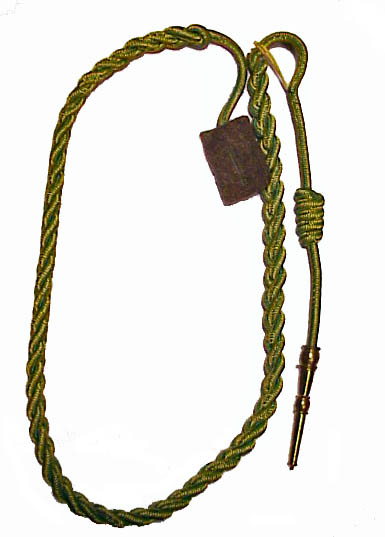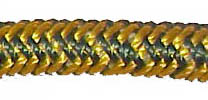American Military Patches, Other Insignia and Decorations
of World War Two by Dr. Howard G. Lanham c.2002
Decorations of the Second World War
Fourragéres
French W.W. I Two Citations

|

|
|
French W.W. II Two Citations

|

|
|
French W.W. II Four Citations

|

|
|
Belgium W.W. II Two Citations (1)

|

|
|
The United States Military has never particularly encouraged the receiving and wearing of foreign decorations by United States
service persons. One major except to this rule is the Fourragére, awarded by the French and Belgium governments. The
Fourragére enjoyed so much prestige that it rated a special section in U.S. Army Uniform Regulations. The French
Fourragére was awarded as a unit decoration, but could be worn either as a unit or individual decoration.
To be awarded the Fourragére a unit must be cited twice in dispatches. Persons who were
members of the unit when it was awarded the French Fourragére may continue to wear it after leaving the unit as an
individual decoration. Those joining a unit, previously awarded the Fourragére, may wear it only while serving in the
unit. The Belgian Fourragére can only be worn by individuals who were members of unit when the unit was
awarded the decoration.
The colors of the
basic Fourragére are the same as the ribbon for the French Croix de Guerre medal: green and red. In addition to the basic two citation Fourragére, if a unit was
cited four times, it is awarded a Fourragére with the colors of the French Medaille Militaire, green and gold.
During W.W. I only one American unit, the 646th Ambulance Service Section, earned this distinction.
In addition, the design of the French cord indicates for which of the two World Wars the decoration was awarded. Those awarded
for W.W. I have the red or yellow of the cord's stitching pattern broken up as accents within a basically green cord. The cords for W.W.II
awards have a continuous strip of red or yellow. In addition to the French award there is a Belgium Fourragére, which is red with
green accents. These are the colors of the Belgium Croix de Guerre medal. Only one type of Belgium Fourragére
is worn by U.S. troops.
The first of the examples above is a World War One Type basic French Fourragére worn by a member of the 16th Infantry during
World War Two. This unit received two citations for World War One and also two citations
for World War Two. The Fourragére worn by this soldier only commenorates the First
World War service. It has the unusual feature of two secondary cords inside the main braid. The additional cords were
not authorized and were mentioned in the 1944 special issue of the National Geographic Magazine on Insignia and
Decorations of the United States Armed Forces as something not approved.
The second example is basic French Fourragére
awarded for the Second World War. The third is one for four awards in the colors of the Medaille Militaire. The fourth shows the Belgium type.
Fourragére worn by the U.S. Army are 36 inches long and those of the Navy and Marine Corps are 38 3/4 inches
long. A pencil-like brass ferrule hangs from the end of the cord. This is a vestige of leather body armor and
was a cord originally used to lace together the front and back sections of the armor. The Fourragére was originally established
by Napoleon and revived during the First World War by the French. The word Fourragére in French means to have foraged. This implies
a soldier who has shown individual initiative. It is worn around the left shoulder, usually suspended by a small
loop of thread and either a button hole sewn in a rectangle of olive drab cloth or a loop from the button that holds the shoulder loops
of the uniform.
NOTES:
- Courtesy: Jay Graybeal
(Thanks to William Emerson for his assistance with this section)
MORE: Netherlands' Lanyard
Back to Medals and Decorations
Index to Site
Back to Home Page